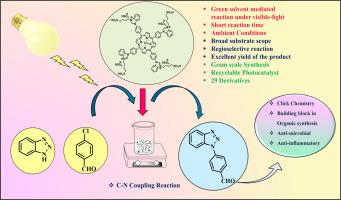Cu-porphyrin-mediated photocatalytic system for C-N coupling: Base-free N-arylation ullmann-type approach to benzotriazole
IF 2.1
3区 化学
Q3 CHEMISTRY, INORGANIC & NUCLEAR
引用次数: 0
Abstract
Heterogeneous photocatalytic C-N cross coupling is an inspiring synthetic approach that proposes environmentally benign way to achieve a range of pharmaceutically important N-arylated heterocyclic derivatives from the corresponding substrates. Nevertheless, despite abundant protocols in catalyst strategy and progress of reaction parameters, C-N coupling of N-H azoles with inactivated aryl halides continues an unsolved obstacle in synthesis. We report a Cu-porphyrin catalyzed visible light-assisted photocatalytic technique for the N-arylation of benzotriazole and other N-heterocyclic compounds with activated and inactivated Ar-X in a photo-chamber at ambient conditions. A novel porphyrin was synthesized from IL based precursor and characterized by 1H NMR, 13C NMR, SEM-EDX. The C-N bond formation advances with high N-position selectivity under optimized photocatalytic conditions under exposure of 5 W LED lights. The ambient conditions and tolerance of diverse activated/inactivated functionalities of the ArX facilitated a library of N-arylated heterocycles with admirable yields (60 %-85 %). The mechanism of C-N bond formation was aided via Ar* formation, trapped by the TEMPO scavenger-adduct (m/z = 261.19) from the GC–MS spectral analysis. Ease of separation and steadiness of the photo-catalyst with respect to efficiency found appreciable by maintaining its structural similarity and reused for five times with yield reduction from 85 % to 74 % under standard conditions. The stability of Cu-PcBILSAM photocatalyst was assessed by proton NMR, FT-IR spectra and concluded that no structural changes found of after 5th run. The heterogeneous characteristic of the porphyrin was further endorsed by seeping experiment during the N-arylation of benzotriazole and a productive protocol to synthesize pharmaceutical precursors.

铜卟啉介导的C-N偶联光催化体系:苯并三唑无碱n-芳基化ullmann型方法
异相光催化C-N交叉偶联是一种鼓舞人心的合成方法,提出了一种环境友好的方法,可以从相应的底物中获得一系列具有重要药用意义的n -芳基化杂环衍生物。然而,尽管在催化剂策略和反应参数方面有大量的研究进展,但N-H唑与失活卤代芳基化合物的C-N偶联仍然是合成中尚未解决的障碍。我们报道了一种铜卟啉催化可见光辅助光催化技术,用于在室温条件下与活化和失活的Ar-X在光室中进行苯并三唑和其他n -杂环化合物的n -芳基化。以IL为前驱体合成了一种新型卟啉,并用1H NMR、13C NMR、SEM-EDX对其进行了表征。在优化的5w LED光催化条件下,C-N键的形成具有较高的n位选择性。环境条件和对ArX各种活化/失活功能的耐受性促进了n -芳基化杂环文库的建立,收率很高(60% - 85%)。GC-MS分析表明,C-N键的形成机制是由TEMPO清除物加合物(m/z = 261.19)捕获的Ar*形成的。易于分离和稳定性的光催化剂的效率发现可观的,保持其结构的相似性和重复使用五次,产率从85%降低到74%,在标准条件下。通过质子核磁共振、红外光谱对Cu-PcBILSAM光催化剂的稳定性进行了评价,经5次试炼后,Cu-PcBILSAM光催化剂的结构没有发生变化。在苯并三唑n -芳基化反应过程中,通过渗透实验进一步验证了卟啉的非均相特性,并确定了药物前体的合成工艺。
本文章由计算机程序翻译,如有差异,请以英文原文为准。
求助全文
约1分钟内获得全文
求助全文
来源期刊

Journal of Organometallic Chemistry
化学-无机化学与核化学
CiteScore
4.40
自引率
8.70%
发文量
221
审稿时长
36 days
期刊介绍:
The Journal of Organometallic Chemistry targets original papers dealing with theoretical aspects, structural chemistry, synthesis, physical and chemical properties (including reaction mechanisms), and practical applications of organometallic compounds.
Organometallic compounds are defined as compounds that contain metal - carbon bonds. The term metal includes all alkali and alkaline earth metals, all transition metals and the lanthanides and actinides in the Periodic Table. Metalloids including the elements in Group 13 and the heavier members of the Groups 14 - 16 are also included. The term chemistry includes syntheses, characterizations and reaction chemistry of all such compounds. Research reports based on use of organometallic complexes in bioorganometallic chemistry, medicine, material sciences, homogeneous catalysis and energy conversion are also welcome.
The scope of the journal has been enlarged to encompass important research on organometallic complexes in bioorganometallic chemistry and material sciences, and of heavier main group elements in organometallic chemistry. The journal also publishes review articles, short communications and notes.
 求助内容:
求助内容: 应助结果提醒方式:
应助结果提醒方式:


